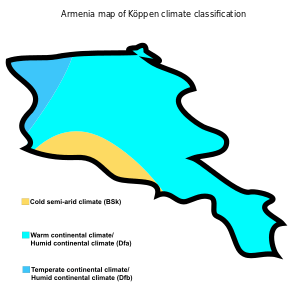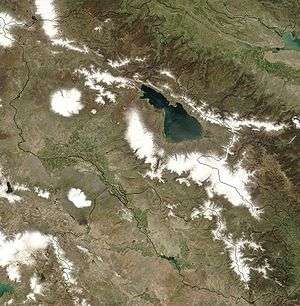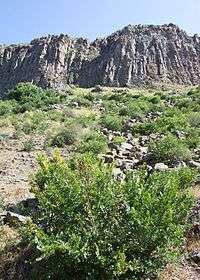Geography of Armenia


Armenia is a landlocked country in the Transcaucasia region, between the Black and Caspian Seas, bordered on the north and east by Georgia and Azerbaijan and on the south and west by Iran and Turkey.
The terrain is mostly mountainous and flat, with fast flowing rivers and few forests but with many trees. The climate is highland continental: hot summers and cold winters. The land rises to 4,095 m above sea-level at Mount Aragats.
Pollution from toxic chemicals such as DDT is not helping the already poor soil quality in many parts of the country.
Armenia is trying to address its environmental problems. It has established a Ministry of Nature Protection and introduced taxes for air and water pollution and solid waste disposal, whose revenues are used for environmental protection activities. Armenia is interested in cooperating with other members of the Commonwealth of Independent States (CIS, a group of 12 former Soviet republics) and with members of the international community on environmental issues. The Armenian Government is working toward closing the Armenian Nuclear Power Plant as soon as alternative energy sources are identified.
Geographic coordinates: 40°00′N 45°00′E / 40.000°N 45.000°E
Physical environment

Armenia is located in southern Transcaucasia, the region southwest of Russia between the Black Sea and the Caspian Sea. Modern Armenia term means Republic of Armenia which occupies part of historical Armenia, whose ancient centres were in the valley of the Araks River and the region around Lake Van in Turkey. Armenia is bordered on the north by Georgia, on the east by Azerbaijan, on the southwest by the Nagorno-Karabagh, on the south by Iran, and on the west by Turkey.
Topography and drainage

Twenty-five million years ago, a geological upheaval pushed up the Earth's crust to form the Armenian Plateau, creating the complex topography of modern Armenia. The Lesser Caucasus range extends through northern Armenia, runs southeast between Lake Sevan and Azerbaijan, then passes roughly along the Armenian-Azerbaijani border to Iran. Thus situated, the mountains make travel from north to south difficult. Geological turmoil continues in the form of devastating earthquakes, which have plagued Armenia. In December 1988, the second largest city in the republic, Leninakan (now Gyumri), was heavily damaged by a massive quake that killed more than 25,000 people.
About half of Armenia's area of approximately 29,800 km2 (11,505.8 sq mi) has an elevation of at least 2,000 m (6,562 ft), and only 3% of the country lies below 650 m (2,133 ft). The lowest points are in the valleys of the Araks River and the Debet River in the far north, which have elevations of 380 and 430 m (1,247 and 1,411 ft), respectively. Elevations in the Lesser Caucasus vary between 2,640 and 3,280 m (8,661 and 10,761 ft). To the southwest of the range is the Armenian Plateau, which slopes southwestward toward the Araks River on the Turkish border. The plateau is masked by intermediate mountain ranges and extinct volcanoes. The largest of these, Mount Aragats, 4,095 meters (13,435 ft) high, is also the highest point in Armenia. Most of the population lives in the western and northwestern parts of the country, where the two major cities, Yerevan and Gyumri (which was called Aleksandropol' during the tsarist period), are located.
The valleys of the Debet and Akstafa rivers form the chief routes into Armenia from the north as they pass through the mountains. Lake Sevan, 72.5 km (45 mi) across at its widest point and 376 km (233.6 mi) long, is by far the largest lake. It lies 2,070 m (6,791 ft) above sea level on the plateau. Terrain is most rugged in the extreme southeast, which is drained by the Bargushat River, and most moderate in the Araks River valley to the extreme southwest. Most of Armenia is drained by the Araks or its tributary, the Hrazdan, which flows from Lake Sevan. The Araks forms most of Armenia's border with Turkey and Iran while the Zangezur Mountains form the border between Armenia's southern province of Syunik and Azerbaijan's adjacent Nakhchivan Autonomous Republic.

Climate
Temperatures in Armenia generally depend upon elevation. Mountain formations block the moderating climatic influences of the Mediterranean Sea and the Black Sea, creating wide seasonal variations with cold snowy winters, and warm to hot summers. On the Armenian Plateau, the mean midwinter temperature is 0 °C (32 °F) to −15 °C (5 °F), and the mean midsummer temperature is 15 °C (59 °F) to 30 °C (86 °F). Average precipitation ranges from 250 millimeters (9.8 in) per year in the lower Araks River valley to 800 millimeters (31.5 in) at the highest altitudes. Despite the harshness of winter in most parts (with frosts reaching −40 °C (−40 °F) and lower in Shirak region), the fertility of the plateau's volcanic soil made Armenia one of the world's earliest sites of agricultural activity.
Environmental problems
A broad public discussion of environmental problems began in the mid-1980s, when the first "green" groups formed in opposition to Yerevan's intense industrial air pollution and to nuclear power generation in the wake of the 1986 reactor explosion at Chernobyl'. Environmental issues helped form the basis of the nationalist independence movement when environmental demonstrations subsequently merged with those for other political causes in the late 1980s. republics as they emerge from the centralized planning system's disastrous approach to resource management. By 1980 the infrequency of sightings of Mount Ararat, which looms about sixty kilometers across the closed Turkish border, became a symbol of worsening air pollution in Yerevan.
Area and boundaries
Area:
total: 29,743 km²
- country comparison to the world: 149
land: 28,454 km²
water: 1,289 km²
Area comparative
- Australia comparative: about one third (33%) the size of Tasmania
- Canada comparative: greater than half (56%) the size of Nova Scotia
- United Kingdom comparative: about one third larger (30%) than Wales
- United States comparative: slightly smaller (7%) than Maryland
- EU comparative: slightly smaller (8%) than Belgium
Land boundaries:
total: 1,570 km
border countries:
Azerbaijan and Nagorno-Karabakh Republic-proper 566 km, Azerbaijan-Nakhchivan exclave 221 km, Georgia 219 km, Iran 44 km, Turkey 311 km
Coastline: 0 km (landlocked)
Maritime claims: none (landlocked)
Elevation extremes:
lowest point:
Debed River 400 m
highest point:
Mount Aragats 4,090 m
Extreme points of Armenia:
North:
Tavush (41°17′N 45°0′E / 41.283°N 45.000°E)
South:
Syunik' (38°49′N 46°10′E / 38.817°N 46.167°E)
West:
Shirak (41°5′N 43°27′E / 41.083°N 43.450°E)
East:
Syunik' (39°13′N 46°37′E / 39.217°N 46.617°E)
Resources and land use
Natural resources: small deposits of gold, copper, molybdenum, zinc, bauxite
Land use:
arable land:
15.75%
permanent crops:
1.99%
other:
82.26% (2012)
Irrigated land: 2,735 km² (2006)
Total renewable water resources: 7.77 m³ (2011) Armenia is considered to be a big water “supplier” in the Caspian basin; as a result, the country lacks water, especially in summer when the rate of evaporation exceeds the amount of precipitation. That is the main reason why people here since ancient times have built water reservoirs and irrigation canal. Lake Sevan contains the largest amount of water in the country.
Freshwater withdrawal (domestic/industrial/agricultural):
total: 2.86 km³/yr (40%/6%/54%)
per capita: 929.7 m³/yr (2010)
Geography Other
landlocked in the Lesser Caucasus Mountains; Sevana Lich (Lake Sevan) is the largest lake in this mountain range
See also
References
 This article incorporates public domain material from the Library of Congress Country Studies website http://lcweb2.loc.gov/frd/cs/.
This article incorporates public domain material from the Library of Congress Country Studies website http://lcweb2.loc.gov/frd/cs/. This article incorporates public domain material from the CIA World Factbook website https://www.cia.gov/library/publications/the-world-factbook/index.html.
This article incorporates public domain material from the CIA World Factbook website https://www.cia.gov/library/publications/the-world-factbook/index.html. This article incorporates public domain material from the United States Department of State website http://www.state.gov/r/pa/ei/bgn/index.htm (Background Notes).
This article incorporates public domain material from the United States Department of State website http://www.state.gov/r/pa/ei/bgn/index.htm (Background Notes).